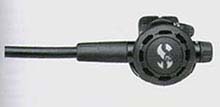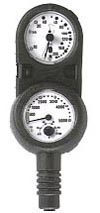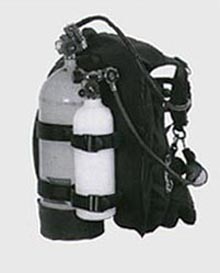Scuba Diving
The self-contained underwater breathing apparatus or scuba diving system, as we know it today, is the result of technological developments and innovations that began almost 300 years ago. Scuba diving is the most extensively used system for breathing underwater by recreational divers throughout the world, and in various forms is also widely used to perform underwater work for military, scientific and commercial purposes.
Advantages and Disadvantages
Essential Equipment
In addition to a mask and fins, basic recreational scuba equipment consists of a cylinder of compressed air attached to a two-stage "demand regulator." The regulator lowers the air pressure in "steps" from the cylinder and dispenses it to the diver as needed.

Cylinders for scuba diving are made of steel or aluminum alloy, and are designed to operate safely at pressures ranging from 2,250 to 3,500 psi (pounds per square inch). As a means of comparison, air pressure at sea level is only about 15 psi. One of the most commonly used types of diving cylinders is made of aluminum alloy, and has a capacity (the quantity of gas that can be compressed into the cylinder) of 80 cubic ft. The amount of time that it takes a diver to use up all of the air in the dive cylinder is dependent on several factors, including, the diver's breathing rate, and the depth to which the diver descends (the deeper the dive, the greater the amount of air used). All cylinders used by scuba divers should be inspected internally at least once a year for damage and corrosion.

The primary function of the "demand regulator" attached to the diving cylinder is to reduce the high-pressure gas supplied by the scuba cylinder to the ambient pressure surrounding the diver at depth. If the diver were to breath compressed air directly from the cylinder, it could easily rupture his lungs. The reduction of air pressure from the diving cylinder to the diver is accomplished in two steps. The first stage of the regulator, which attaches to the cylinder valve, reduces the high pressure in the cylinder to an intermediate pressure approximately 140 psi over ambient pressure. This intermediate pressure fills a low-pressure hose that connects the first stage of the regulator to the second stage. The second stage, contained in the diver's mouthpiece, reduces the intermediate pressure to the ambient pressure. The regulator is known as a "demand regulator" because it only supplies air when the diver "demands" it; that is, gas flows through the regulator only when the diver inhales.
Critical for Safety
 Other devices, while not directly involved in the breathing circuit of the recreational scuba diver, are nonetheless critical for safety. These include a Pressure Gauge, depth gauge, and dive timer. These instruments inform the diver about the amount of air left in the cylinder, their depth in the water, and how much time has been spent underwater. A diver who exceeds the prescribed depth or time spent underwater, may become susceptible to nitrogen narcosis, and/or decompression sickness, which can be fatal.
Other devices, while not directly involved in the breathing circuit of the recreational scuba diver, are nonetheless critical for safety. These include a Pressure Gauge, depth gauge, and dive timer. These instruments inform the diver about the amount of air left in the cylinder, their depth in the water, and how much time has been spent underwater. A diver who exceeds the prescribed depth or time spent underwater, may become susceptible to nitrogen narcosis, and/or decompression sickness, which can be fatal.
Two additional items generally considered essential for the scuba diver are a "BC" or "BCD" (buoyancy compensator device) and a dive knife. Almost all BCs are worn like a vest, and include a band for mounting the air cylinder. The BC contains an air bladder that the diver inflates or deflates to maintain control over buoyancy, thereby avoiding uncontrolled ascents and descents.
In addition to the BC, few divers enter the water without a dive knife. Most divers carry them in the event that they become entangled in a line, net, or some other gear, and need to cut themselves free. A dive knife can also be used as a signaling device by banging it against a dive cylinder.
Advanced scuba diving technolgy details Click Here...
 Deep Sea Crabs
Deep Sea Crabs